Yamaha EZ-200 User Manual
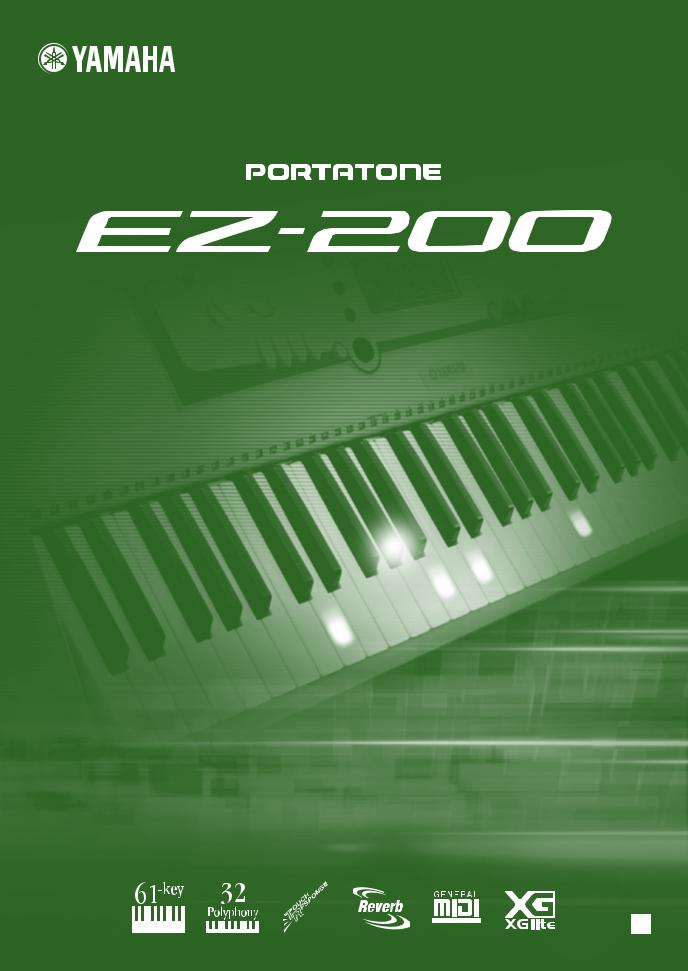
Owner’s Manual
EN
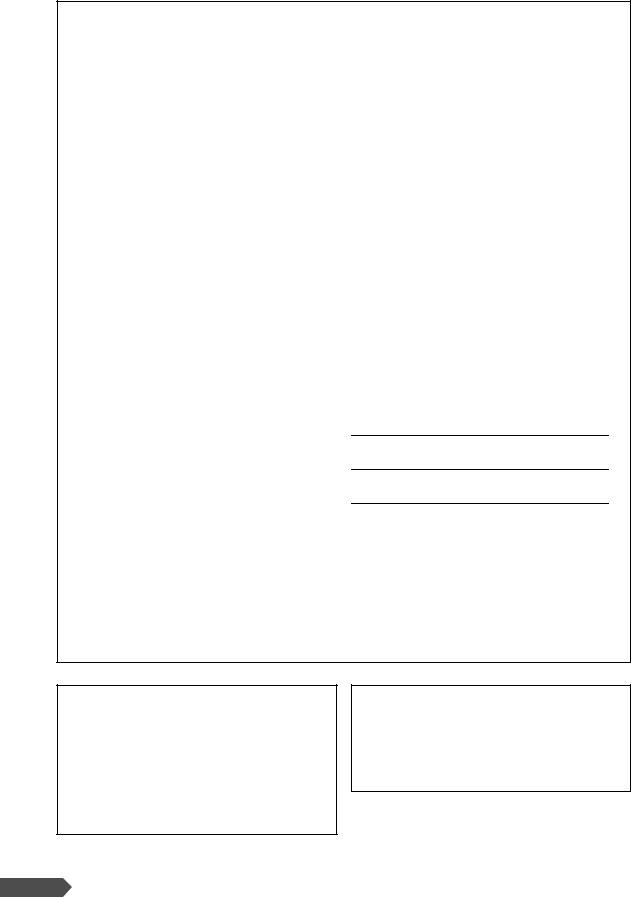
SPECIAL MESSAGE SECTION
This product utilizes batteries or an external power supply (adapter). DO NOT connect this product to any power supply or adapter other than one described in the manual, on the name plate, or specifically recommended by Yamaha.
This product should be used only with the components supplied or; a cart, rack, or stand that is recommended by Yamaha. If a cart, etc., is used, please observe all safety markings and instructions that accompany the accessory product.
This product may also use “household” type batteries. Some of these may be rechargeable. Make sure that the battery being charged is a rechargeable type and that the charger is intended for the battery being charged.
When installing batteries, do not mix batteries with new, or with batteries of a different type. Batteries MUST be installed correctly. Mismatches or incorrect installation may result in overheating and battery case rupture.
Warning:
SPECIFICATIONS SUBJECT TO CHANGE:
The information contained in this manual is believed to be correct at the time of printing. However, Yamaha reserves the right to change or modify any of the specifications without notice or obligation to update existing units.
Do not attempt to disassemble, or incinerate any battery. Keep all batteries away from children. Dispose of used batteries promptly and as regulated by the laws in your area. Note: Check with any retailer of household type batteries in your area for battery disposal information.
Disposal Notice:
This product, either alone or in combination with an amplifier and headphones or speaker/s, may be capable of producing sound levels that could cause permanent hearing loss. DO NOT operate for long periods of time at a high volume level or at a level that is uncomfortable. If you experience any hearing loss or ringing in the ears, you should consult an audiologist.
IMPORTANT: The louder the sound, the shorter the time period before damage occurs.
NOTICE:
Service charges incurred due to a lack of knowledge relating to how a function or effect works (when the unit is operating as designed) are not covered by the manufacturer’s warranty, and are therefore the owners responsibility. Please study this manual carefully and consult your dealer before requesting service.
ENVIRONMENTAL ISSUES:
Yamaha strives to produce products that are both user safe and environmentally friendly. We sincerely believe that our products and the production methods used to produce them, meet these goals. In keeping with both the letter and the spirit of the law, we want you to be aware of the following:
Battery Notice:
This product MAY contain a small non-rechargeable battery which (if applicable) is soldered in place. The average life span of this type of battery is approximately five years. When replacement becomes necessary, contact a qualified service representative to perform the replacement.
Should this product become damaged beyond repair, or for some reason its useful life is considered to be at an end, please observe all local, state, and federal regulations that relate to the disposal of products that contain lead, batteries, plastics, etc. If your dealer is unable to assist you, please contact Yamaha directly.
NAME PLATE LOCATION:
The name plate is located on the bottom of the product. The model number, serial number, power requirements, etc., are located on this plate.You should record the model number, serial number, and the date of purchase in the spaces provided below and retain this manual as a permanent record of your purchase.
Model
Serial No.
Purchase Date
PLEASE KEEP THIS MANUAL
92-BP (bottom)
OBSERVERA!
Apparaten kopplas inte ur växelströmskällan (nätet) så länge som den ar ansluten till vägguttaget, även om själva apparaten har stängts av.
ADVARSEL: Netspæendingen til dette apparat er IKKE afbrudt, sålæenge netledningen siddr i en stikkontakt, som er t endt — også selvom der or slukket på apparatets afbryder.
VAROITUS: Laitteen toisiopiiriin kytketty käyttökytkin ei irroita koko laitetta verkosta.
Entsorgung leerer Batterien (nur innerhalb Deutschlands)
Leisten Sie einen Beitrag zum Umweltschutz. Verbrauchte Batterien oder Akkumulatoren dürfen nicht in den Hausmüll. Sie können bei einer Sammelstelle für Altbatterien bzw. Sondermüll abgegeben werden. Informieren Sie sich bei Ihrer Kommune.
(battery)
(standby)
2 EZ-200 Owner’s Manual

FCC INFORMATION (U.S.A.)
1. IMPORTANT NOTICE: DO NOT MODIFY THIS UNIT!
This product, when installed as indicated in the instructions contained in this manual, meets FCC requirements. Modifications not expressly approved by Yamaha may void your authority, granted by the FCC, to use the product.
2. IMPORTANT: When connecting this product to accessories and/or another product use only high quality shielded cables. Cable/s supplied with this product MUST be used. Follow all installation instructions. Failure to follow instructions could void your FCC authorization to use this product in the USA.
3. NOTE: This product has been tested and found to comply with the requirements listed in FCC Regulations, Part 15 for Class “B” digital devices. Compliance with these requirements provides a reasonable level of assurance that your use of this product in a residential environment will not result in harmful interference with other electronic devices. This equipment generates/ uses radio frequencies and, if not installed and used according to the instructions found in the users manual, may cause interference harmful to the operation of
other electronic devices. Compliance with FCC regulations does not guarantee that interference will not occur in all installations. If this product is found to be the source of interference, which can be determined by turning the unit “OFF” and “ON”, please try to eliminate the problem by using one of the following measures:
Relocate either this product or the device that is being affected by the interference.
Utilize power outlets that are on different branch (circuit breaker or fuse) circuits or install AC line filter/s.
In the case of radio or TV interference, relocate/reorient the antenna. If the antenna lead-in is 300 ohm ribbon lead, change the lead-in to co-axial type cable.
If these corrective measures do not produce satisfactory results, please contact the local retailer authorized to distribute this type of product. If you can not locate the appropriate retailer, please contact Yamaha Corporation of America, Electronic Service Division, 6600 Orangethorpe Ave, Buena Park, CA90620
The above statements apply ONLY to those products distributed by Yamaha Corporation of America or its subsidiaries.
* This applies only to products distributed by YAMAHA CORPORATION OF AMERICA. |
|
(class B) |
||
● COPYRIGHT NOTICE |
|
|
|
|
q Nine of the demo-songs (or compositions) included in this key- |
Since U Been Gone |
|
||
board are as follows: |
• Words and Music by Martin Sandberg and Lukasz Gottwald |
|||
Bad Day |
• Copyright © 2004 by Miratone AB and Kasz Money Publishing |
|||
• Words and Music by Daniel Powter |
• All Rights for Miratone AB in the world Administered by Zomba |
|||
• Copyright © 2006 by Song 6 Music |
Music Publishers Ltd. |
|
|
|
• All Rights Administered by Ensign Music LLC |
• All Rights for Zomba Music Publishers Ltd. in the U.S. Adminis- |
|||
• International Copyright Secured All Rights Reserved |
tered by Zomba Enterprises, Inc. |
All Rights Reserved |
||
Dancing Queen |
• International Copyright Secured |
|||
You’re Beautiful |
|
|
||
• from MAMMA MIA! |
|
|
||
• Words and Music by Benny Andersson, Bjorn Ulvaeus and Stig |
• Words and Music by James Blunt, Sacha Skarbek and Amanda |
|||
Anderson |
Ghost |
|
|
|
• Copyright © 1977 UNION SONGS MUSIKFORLAG AB |
• © 2005 EMI MUSIC PUBLISHING LTD., UNIVERSAL |
|||
• Copyright Renewed |
MUSIC PUBLISHING LTD. and BUCKS MUSIC LTD. |
|||
• All Rights in the United States and Canada Controlled and |
• All Rights for EMI MUSIC PUBLISHING LTD. in the U.S. and |
|||
Administered by UNIVERSAL — SONGS OF POLYGRAM |
Canada Controlled and Administered by EMI BLACKWOOD |
|||
INTERNATIONAL, INC. and EMI GROVE PARK MUSIC, INC. |
MUSIC INC. |
|
|
|
• All Rights Reserved Used by Permission |
• All Rights for UNIVERSAL MUSIC PUBLISHING LTD. in the |
|||
Daughters |
U.S. and Canada Controlled and Administered by UNIVERSAL |
|||
— SONGS OF POLYGRAM INTERNATIONAL, INC. |
||||
• Words and Music by John Mayer |
||||
• All Rights for BUCKS MUSIC LTD. in the U.S. Administered by |
||||
• Copyright © 2003 Specific Harm Music (ASCAP) |
||||
DAVID PLATZ MUSIC (USA) INC. |
||||
• International Copyright Secured All Rights Reserved |
||||
• All Rights Reserved |
International Copyright Secured Used by |
|||
Fallin’ |
||||
Permission |
|
|
||
• Words and Music by Alicia Keys |
Your Song |
|
|
|
• © 2001 EMI APRIL MUSIC INC. and LELLOW PRODUC- |
|
|
||
• Words and Music by Elton John and Bernie Taupin |
||||
TIONS |
||||
• Copyright © 1969 UNIVERSAL/DICK JAMES MUSIC LTD. |
||||
• All Rights Controlled and Administered by EMI APRIL MUSIC INC. |
||||
• Copyright Renewed |
|
|
||
• All Rights Reserved International Copyright Secured Used by |
|
|
||
• All Rights in the United States and Canada Controlled and |
||||
Permission |
||||
Administered by UNIVERSAL — SONGS OF POLYGRAM |
||||
Hey Jude |
||||
INTERNATIONAL, INC. |
|
|||
• Words and Music by John Lennon and Paul McCartney |
• All Rights Reserved |
Used by Permission |
||
• Copyright © 1968 Sony/ATV Songs LLC |
|
|
|
|
• Copyright Renewed |
w One of the demo-songs (or compositions) included in this key- |
|||
• All Rights Administered by Sony/ATV Music Publishing, |
board is as follows: |
|
|
|
8 Music Square West, Nashville, TN 37203 |
Composition Title |
: Just The Way You Are |
||
• International Copyright Secured All Rights Reserved |
||||
Composer’s Name |
: Joel |
0273671 |
||
Linus And Lucy |
||||
Copyright Owner’s Name : EMI MUSIC PUBLISHING LTD |
||||
•By Vince Guaraldi
•Copyright © 1965 LEE MENDELSON FILM PRODUCTIONS, INC. CAUTION: All Rights Reserved, Unauthorized copying, public per-
• Copyright Renewed |
formance and broadcasting are strictly prohibited regarding the above |
• International Copyright Secured All Rights Reserved |
ten demo-songs. |
EZ-200 Owner’s Manual |
3 |
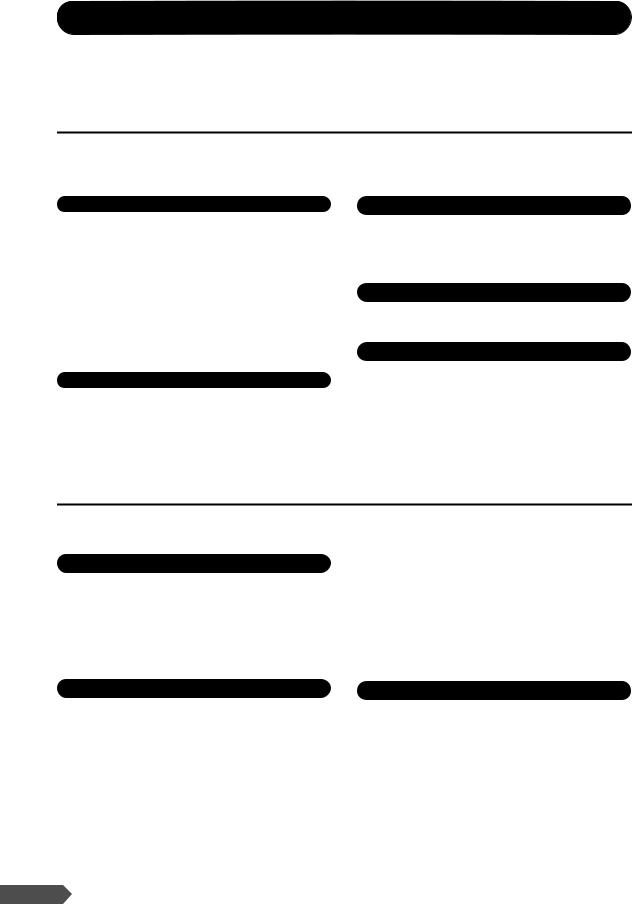
PRECAUTIONS
PLEASE READ CAREFULLY BEFORE PROCEEDING
* Please keep this manual in a safe place for future reference.
 WARNING
WARNING
Always follow the basic precautions listed below to avoid the possibility of serious injur y or even death from electrical shock, short-circuiting, damages, fire or other hazards. These precautions include, but are not limited to, the following:
Power supply/AC power adaptor
•Only use the voltage specified as correct for the instrument. The required voltage is printed on the name plate of the instrument.
•Use the specified adaptor (PA-3C, PA-130, or an equivalent recommended by Yamaha) only. Using the wrong adaptor can result in damage to the instrument or overheating.
•Check the electric plug periodically and remove any dirt or dust which may have accumulated on it.
•Do not place the AC adaptor cord near heat sources such as heaters or radiators, and do not excessively bend or otherwise damage the cord, place heavy objects on it, or place it in a position where anyone could walk on, trip over, or roll anything over it.
Do not open
•Do not open the instrument or attempt to disassemble the internal parts or modify them in any way. The instrument contains no user-serviceable parts. If it should appear to be malfunctioning, discontinue use immediately and have it inspected by qualified Yamaha service personnel.
Water warning
•Do not expose the instrument to rain, use it near water or in damp or wet conditions, or place containers on it containing liquids which might spill into any openings.
•Never insert or remove an electric plug with wet hands.
Fire warning
•Do not put burning items, such as candles, on the unit. A burning item may fall over and cause a fire.
If you notice any abnormality
•If the AC adaptor cord or plug becomes frayed or damaged, or if there is a sudden loss of sound during use of the instrument, or if any unusual smells or smoke should appear to be caused by it, immediately turn off the power switch, disconnect the adaptor plug from the outlet, and have the instrument inspected by qualified Yamaha service personnel.
 CAUTION
CAUTION
Always follow the basic precautions listed below to avoid the possibility of physical injur y to you or others, or damage to the instrument or other property. These precautions include, but are not limited to, the following:
Power supply/AC power adaptor
•When removing the electric plug from the instrument or an outlet, always hold the plug itself and not the cord.
•Unplug the AC power adaptor when not using the instrument, or during electrical storms.
•Do not connect the instrument to an electrical outlet using a multipleconnector. Doing so can result in lower sound quality, or possibly cause overheating in the outlet.
•Do not attempt to recharge batteries that are not intended to be charged.
•When the batteries run out, or if the instrument is not to be used for a long time, remove the batteries from the instrument to prevent possible leakage of the battery fluid.
•Keep batteries away from children.
•If the batteries do leak, avoid contact with the leaked fluid. If the battery fluid should come in contact with your eyes, mouth, or skin, wash immediately with water and consult a doctor. Battery fluid is corrosive and may possibly cause loss of sight or chemical burns.
Battery
•Always make sure all batteries are inserted in conformity with the +/- polarity markings. Failure to do so might result in overheating, fire, or battery fluid leakage.
•Always replace all batteries at the same time. Do not use new batteries together with old ones. Also, do not mix battery types, such as alkaline batteries with manganese batteries, or batteries from different makers, or different types of batteries from the same maker, since this can cause overheating, fire, or battery fluid leakage.
•Do not dispose of batteries in fire.
Location
•Do not expose the instrument to excessive dust or vibrations, or extreme cold or heat (such as in direct sunlight, near a heater, or in a car during the day) to prevent the possibility of panel disfiguration or damage to the internal components.
•Do not use the instrument in the vicinity of a TV, radio, stereo equipment, mobile phone, or other electric devices. Otherwise, the instrument, TV, or radio may generate noise.
•Do not place the instrument in an unstable position where it might accidentally fall over.
(4)-11 1/2
4 EZ-200 Owner’s Manual
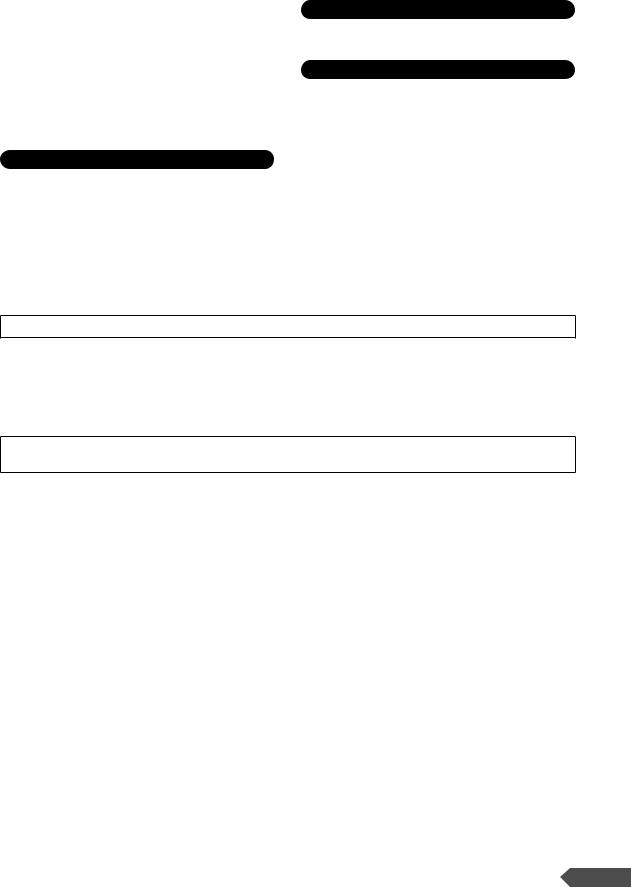
•Before moving the instrument, remove all connected adaptor and other cables.
•When setting up the product, make sure that the AC outlet you are using is easily accessible. If some trouble or malfunction occurs, immediately turn off the power switch and disconnect the plug from the outlet. Even when the power switch is turned off, electricity is still flowing to the product at the minimum level. When you are not using the product for a long time, make sure to unplug the power cord from the wall AC outlet.
•Use only the stand specified for the instrument. When attaching the stand or rack, use the provided screws only. Failure to do so could cause damage to the internal components or result in the instrument falling over.
Connections
•Before connecting the instrument to other electronic components, turn off the power for all components. Before turning the power on or off for all components, set all volume levels to minimum. Also, be sure to set the volumes of all components at their minimum levels and gradually raise the volume controls while playing the instrument to set the desired listening level.
Maintenance
•When cleaning the instrument, use a soft, dry cloth. Do not use paint thinners, solvents, cleaning fluids, or chemical-impregnated wiping cloths.
Handling caution
•Do not insert a finger or hand in any gaps on the instrument.
•Never insert or drop paper, metallic, or other objects into the gaps on the panel or keyboard. If this happens, turn off the power immediately and unplug the power cord from the AC outlet. Then have the instrument inspected by qualified Yamaha service personnel.
•Do not place vinyl, plastic or rubber objects on the instrument, since this might discolor the panel or keyboard.
•Do not rest your weight on, or place heavy objects on the instrument, and do not use excessive force on the buttons, switches or connectors.
•Do not use the instrument/device or headphones for a long period of time at a high or uncomfortable volume level, since this can cause permanent hearing loss. If you experience any hearing loss or ringing in the ears, consult a physician.
Yamaha cannot be held responsible for damage caused by improper use or modifications to the instrument.
Always turn the power off when the instrument is not in use.
When using a power adaptor, even when the power switch is in the “STANDBY” position, electricity is still flowing to the instrument at the minimum level. When you are not using the instrument for a long time, make sure you unplug the AC power adaptor from the wall AC outlet.
Make sure to discard used batteries according to local regulations.
•The illustrations and LCD screens as shown in this owner’s manual are for instructional purposes only, and may appear somewhat different from those on your instrument.
● COPYRIGHT NOTICE
This product incorporates and bundles computer programs and contents in which Yamaha owns copyrights or with respect to which it has license to use others’ copyrights. Such copyrighted materials include, without limitation, all computer software, style files, MIDI files, WAVE data, musical scores and sound recordings. Any unauthorized use of such programs and contents outside of personal use is not permitted under relevant laws. Any violation of copyright has legal consequences.
DON’T MAKE, DISTRIBUTE OR USE ILLEGAL COPIES.
Copying of the commercially available musical data including but not limited to MIDI data and/or audio data is strictly prohibited except for your personal use.
● Trademarks
•The company names and product names in this Owner’s Manual are the trademarks or registered trademarks of their respective companies.
(4)-11 2/2
EZ-200 Owner’s Manual |
5 |

Congratulations and thank you for purchasing the Yamaha EZ-200 PortaTone!
Please read this owner’s manual carefully before using the instrument in order to take full advantage of its various features.
Make sure to keep this manual in a safe and handy place even after you finish reading, and refer to it often when you need to better understand an operation or function.
Main features
The EZ-200 is a sophisticated yet easy-to–use keyboard with the following features and functions.
■ Yamaha Education Suite 5 (Y.E.S. 5)
The EZ-200 features the new Yamaha Education Suite—a set of learning tools that utilize the latest technology to make studying and practicing music more fun and fulfilling than ever before!
The Yamaha Education Suite includes:
● Lesson............................................................................................................ |
page 29 |
The convenient and easy-to-use Lesson feature, guides you through the parts of a song—just like a patient teacher! Select from any one of 100 songs on the EZ-200, and learn the leftand righthand parts independently at first, then together. Lesson features three easy steps that help you master each song: Listen and Learn, Timing and Waiting.
● Built-in lighted Key Guide..................................................................... |
pages 29, 50 |
When you are using the Lesson feature or the Dictionary, the key indicators tell you which keys to play. Also, during song playback, they show the keys that are playing.
● Fingering Guide............................................................................................. |
page 29 |
The Fingering guide is shown on the display and shows you how to play the keyboard.
● Dictionary....................................................................................................... |
page 50 |
Dictionary is a built-in “chord encyclopedia” that teaches you how to play specific chords by showing lighting keyboards—perfect for when you know the name of a chord and want to quickly learn how to play it!
● Notice your Grade ......................................................................................... |
page 32 |
The EZ-200 also has the Grade feature. Grade is a virtual “teacher,” evaluating your practice sessions and rating your performance over four levels.
■ Portable Grand™ ..................................................................... |
page 17 |
The EZ-200 also has a Portable Grand function for realistic piano performance with TOUCH sensitivity. Pressing the [PORTABLE GRAND] button instantly calls up the authentic “Stereo Sampled Piano” voice and configures the entire EZ-200 for optimum piano play. Special Pianist styles—with piano-only accompaniment—are also provided.
■ XGlite voices............................................................................................. |
page 58 |
The EZ-200 has total of 375 high-quality instrument voices (Stereo Grand Piano, 361 XGlite Voices, 12 Drum Kits and Sound Effect Kit) and features 32-note polyphony.
●100 dynamic auto accompaniment Styles.
●Built-in convenient tap tempo function.
●MIDI terminals for interfacing with other instrument or computer.
Supplied accessories
•Music rest
•Song Book
•Owner’s Manual
Music Rest
Insert the bottom edge of the included music rest into the slot located at the top rear of the EZ-200 control panel.
6 EZ-200 Owner’s Manual

Contents
Main features ............................................................. |
6 |
Supplied accessories ................................................. |
6 |
Setting Up |
8 |
Power Requirements ................................................. |
8 |
Connecting headphones (PHONES/OUTPUT Jack) .9 |
|
Connecting a footswitch (SUSTAIN Jack) ................. |
9 |
Using the MIDI Terminals .......................................... |
9 |
Turn on the power...................................................... |
9 |
Panel Controls and Terminals |
10 |
Front Panel .............................................................. |
10 |
Rear Panel ............................................................... |
10 |
— Quick Guide — |
|
Step 1 |
|
Playing the Songs |
12 |
Turn the power on and adjust the volume................ |
12 |
Listen to the Demo Songs........................................ |
13 |
Selecting and listening to a specific Song................ |
13 |
Step 2 |
|
Changing the Voices |
16 |
Try playing a variety of instrument Voices ............... |
16 |
Playing the Grand Piano Voice ................................ |
17 |
Drum kits.................................................................. |
18 |
Step 3 |
|
Play with the metronome |
20 |
Start the metronome ................................................ |
20 |
Step 4 |
|
Play with a Style |
23 |
Selecting a rhythm of a Style ................................... |
23 |
Playing with a Style.................................................. |
24 |
Basic Operation and Displays |
26 |
Basic Operation ....................................................... |
26 |
Display ..................................................................... |
28 |
Song Lesson |
29 |
Practice by using the Light Guide function............... |
29 |
Practice by using the Fingering guide...................... |
29 |
Lesson 1 (Listen & Learn)........................................ |
30 |
Lesson 2 (Timing) .................................................... |
31 |
Lesson 3 (Waiting) ................................................... |
32 |
Song settings |
33 |
Changing the Melody Voice ..................................... |
33 |
Song Volume ........................................................... |
33 |
Mute ......................................................................... |
34 |
Practice Makes Perfect ............................................ |
35 |
Handy Performance Features |
36 |
Setting the Split Point .............................................. |
36 |
Transpose ............................................................... |
37 |
Tuning ..................................................................... |
37 |
One Touch Setting .................................................. |
38 |
Changing the tempo of the Song/Style.................... |
38 |
Touch Response ..................................................... |
39 |
Adjusting the Main Voice Parameters ..................... |
40 |
Play With a Variety of Effects |
41 |
Adding Reverb......................................................... |
41 |
Adding Panel Sustain .............................................. |
42 |
Style (Auto Accompaniment) Functions |
43 |
Various ways to start and stop Style playback ........ |
43 |
Pattern Variation (Sections) .................................... |
45 |
Adjusting the Style Volume ..................................... |
47 |
Playing Auto Accompaniment Chords |
48 |
Easy Chords............................................................ |
48 |
Standard Chords ..................................................... |
48 |
Looking up Chords Using the Chord Dictionary ...... |
50 |
Function Settings |
52 |
Select the item and change the value ..................... |
52 |
About MIDI |
54 |
What is MIDI?.......................................................... |
54 |
What You Can Do With MIDI................................... |
54 |
Transferring Performance Data To and |
|
From Another Instrument..................................... |
55 |
Troubleshooting ........................................................... |
57 |
Voice List....................................................................... |
58 |
Maximum Polyphony ............................................... |
58 |
Drum Kit List ................................................................. |
63 |
Style List........................................................................ |
66 |
Effect Type List ............................................................. |
67 |
MIDI Implementation Chart .......................................... |
68 |
MIDI Data Format .......................................................... |
70 |
Effect map ............................................................... |
70 |
Specifications ............................................................... |
71 |
Index .............................................................................. |
72 |
EZ-200 Owner’s Manual |
7 |
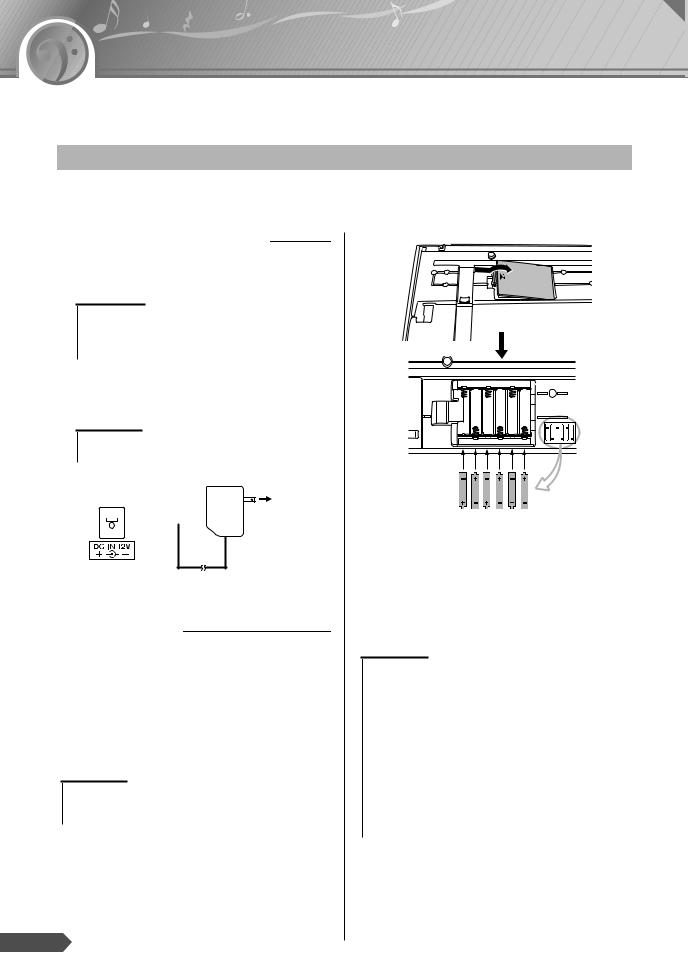
Setting Up
Be sure to do the following operations BEFORE turning on the power.
Power Requirements
Although the instrument will run either from an optional AC adaptor or batteries, Yamaha recommends use of an AC adaptor whenever possible. An AC adaptor is more environmentally friendly than batteries and does not deplete resources.
■ Using an AC Power Adaptor
q Make sure that the power of the instrument is off (display is blank, except for notation staff).
 WARNING
WARNING
•Use the specified adaptor (PA-3C, PA-130, or an equivalent recommended by Yamaha) only. The use of other adaptors may result in irreparable damage to both the adaptor and the instrument.
w Connect the AC adaptor to the power supply jack.
e Plug the AC adaptor into an AC outlet.
 CAUTION
CAUTION
•Unplug the AC Power Adaptor when not using the instrument, or during electrical storms.
e
AC outlet
w




■Using Batteries
q Open the battery compartment cover located on the instrument’s bottom panel.
w Insert the six new alkaline batteries, being careful to follow the polarity markings on the side of the compartment.
e Replace the compartment cover, making sure that it locks firmly in place.
 CAUTION
CAUTION
•Never connect or disconnect the AC power adaptor when the power is on and the batteries are installed. Doing so will turn the power off.
For battery operation the instrument requires six 1.5V “AA” size, LR6 or equivalent batteries. (Alkaline batteries are recommended.) When battery power becomes too low for proper operation, the volume may be reduced, the sound may be distorted, and other problems may occur. When this happens, make sure to replace all batteries, following the precautions listed below.
 CAUTION
CAUTION
•Use alkaline batteries for this instrument. Other types of batteries (including rechargeable batteries) may have sudden drops of power when battery power becomes low.
•Make sure to install the batteries with the proper orientation, maintaining the correct polarity (as shown). Incorrect battery installation may result in heat, fire and/or leaking of corrosive chemicals.
•When the batteries run down, replace them with a complete set of six new batteries. NEVER mix old and new batteries. Do not use different kinds of batteries (e.g. alkaline and manganese) at the same time.
•If the instrument is not to be in use for a long time, remove the batteries from it, in order to prevent possible fluid leakage from the battery.
8 EZ-200 Owner’s Manual

Setting Up
Make all necessary connections BEFORE turning the power on.
Connecting headphones (PHONES/OUTPUT Jack) |
|
Using the MIDI Terminals |
||||||||||||||||||||||||||
|
|
|
|
|
|
|
|
|
|
|
|
|
|
|
|
|
|
|
|
|
|
|
|
|
|
|
|
|
|
|
|
|
|
|
|
|
|
|
|
|
|
|
|
|
|
|
|
|
|
|
|
|
|
|
|
|
|
|
|
|
|
|
|
|
|
|
|
|
|
|
|
|
|
|
|
|
|
|
|
|
|
|
|
|
|
|
|
|
|
|
|
|
|
|
|
|
|
|
|
|
|
|
|
|
|
|
|
|
|
|
|
|
|
|
|
The EZ-200 speakers are automatically shut off when |
other MIDI instrument |
|
a plug is inserted into this jack. The PHONES/OUT- |
|
|
PUT jack also functions as an external output. |
|
|
You can connect the PHONES/OUTPUT jack to a |
The instrument also features MIDI terminals, allow- |
|
ing you to interface the instrument with other MIDI |
||
keyboard amplifier, stereo system, mixer, tape |
||
instruments or computers. (For more information, see |
||
recorder, or other line-level audio device to send the |
||
page 54.) |
||
instrument’s output signal to that device. |
||
|
||
WARNING |
NOTE |
|
|
||
• Avoid listening with the headphones at high volume for |
• MIDI cables (sold separately) must be used for connecting to |
|
MIDI devices. They can be bought at music stores, etc. |
||
long periods of time; doing so may not only result in ear |
||
|
||
fatigue, it may be damaging to your hearing. |
|
|
|
|
Turn on the power |
|
CAUTION |
|
|
|
• To prevent damage to the speakers, set the volume of the |
|
|
|
external devices at the minimum setting and turn power |
Press the [STANDBY/ON] switch to turn on the |
|
|
off the devices before connecting them. Failure to |
power. Pressing the switch again turns the power off. |
|
|
observe these precautions may result in electric shock or |
||
|
When you first turn on the power, make sure to turn |
||
|
equipment damage. Also, be sure to set the volumes of |
||
|
external devices at their minimum levels and gradually |
down the volume of the instrument by pressing the |
|
|
raise the volume controls while playing the instrument to |
MASTER VOLUME [-] button several times. While |
|
|
set the desired listening level. |
||
|
playing the keyboard, adjust the volume level by using |
||
|
|
|
|
|
|
|
|
|
|
|
the MASTER VOLUME [+] and [-] buttons. |
Connecting a footswitch (SUSTAIN Jack)
|
|
|
|
|
|
|
|
|
All panel settings as well as the settings made via the |
|||
|
|
|
|
|
|
|
|
|
||||
|
|
|
|
|
|
|
|
|
||||
|
|
|
|
|
|
|
|
|
display are reset to their default values whenever the |
|||
|
|
|
|
|
|
|
|
|
||||
The sustain function lets you produce a natural sustain |
power is turned off. |
|||||||||||
|
|
|
|
|||||||||
as you play by pressing an optional footswitch. Plug |
|
|
|
|
||||||||
|
|
CAUTION |
|
|||||||||
the Yamaha FC4 or FC5 footswitch into this jack and |
|
|
|
|||||||||
|
|
• When using a power adaptor, even when the power is off, |
||||||||||
use it to switch sustain on and off. |
|
|
||||||||||
|
|
|
|
|
|
|
|
|
|
|
a small amount of electricity is still being consumed by |
|
|
NOTE |
|
|
the instrument.When you are not using the instrument for |
||||||||
|
|
|
a long time, make sure to unplug the AC power adaptor |
|||||||||
|
• Make sure that the footswitch plug is properly connected to |
|
|
from the wall AC outlet, and/or remove the batteries from |
||||||||
|
|
|
the instrument. |
|||||||||
|
the SUSTAIN jack before turning on the power. |
|
|
|||||||||
|
|
|
|
|
||||||||
•Do not press the footswitch while turning the power on. Doing this changes the recognized polarity of the footswitch, resulting in reversed footswitch operation.
EZ-200 Owner’s Manual |
9 |
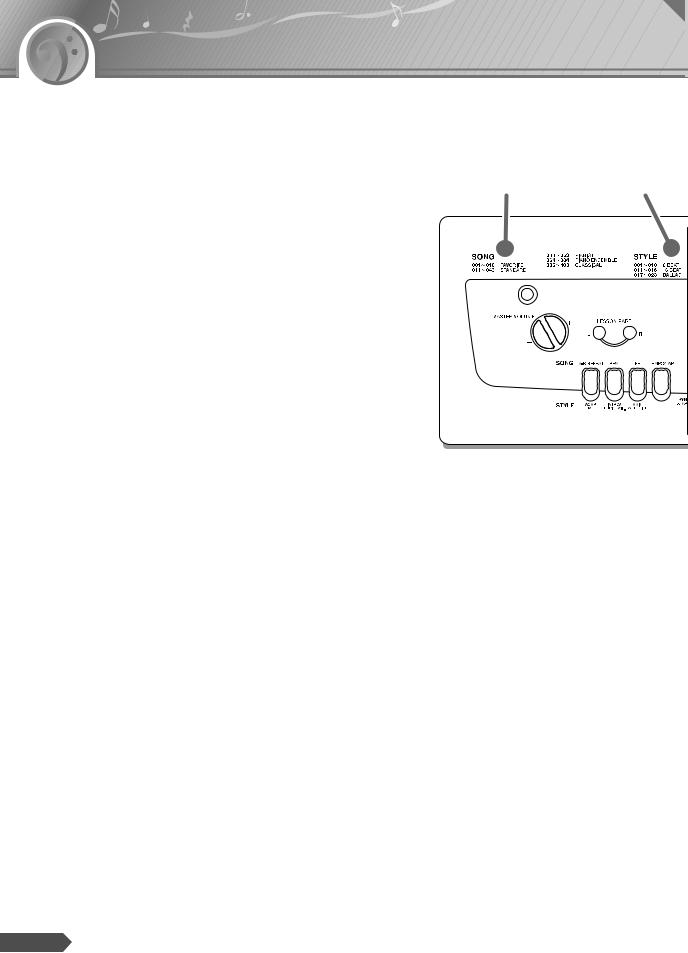
Panel Controls and Terminals
■ Front Panel
q [STANDBY/ON] switch .................................... |
page 9, 26 |
|
w MASTER VOLUME |
|
|
[+] button ....................................................... |
pages 9, 26 |
|
[-] button ........................................................ |
pages 9, 26 |
|
e LESSON PART |
|
|
[L] button ............................................................. |
page 30 |
|
[R] button............................................................. |
page 30 |
|
r [LISTEN & LEARN] button.................................. |
page 31 |
|
t [TIMING] button................................................... |
page 31 |
|
y [WAITING] button ................................................ |
page 32 |
|
u [FUNCTION] button..................................... |
pages 52, 27 |
|
i [SONG] button............................................. |
pages 13, 27 |
|
o [STYLE] button............................................ |
pages 23, 27 |
|
!0[VOICE] button ............................................ |
pages 16, 27 |
|
!1Number buttons [0]–[9], [+], [-]........................... |
page 27 |
|
!2[DEMO] button..................................................... |
page 13 |
|
!3[METRONOME ON/OFF] button ......................... |
page 20 |
|
|
|
|
When the Song mode |
|
|
|
|
|
!4[A-B REPEAT] button.......................................... |
page 35 |
|
!5[REW] button ....................................................... |
page 14 |
|
!6[FF] button ........................................................... |
page 14 |
|
!8[PAUSE] button.................................................... |
page 14 |
|
|
|
|
When the Style mode |
|
|
|
|
|
!4[ACMP ON/OFF] button ...................................... |
page 24 |
|
!5[INTRO/ENDING/rit.] button................................ |
page 45 |
|
!6[MAIN/AUTO FILL] button................................... |
page 45 |
|
!8[SYNC START] button......................................... |
page 24 |
|
|
|
|
!7[TEMPO/TAP] button........................................... |
page 38 |
|
!9[START/STOP] button ......................................... |
page 26 |
|
@0[PORTABLE GRAND] button.............................. |
page 17 |
|
@1[LIGHT ON/OFF] button ...................................... |
page 29 |
|
@2[TOUCH ON/OFF] button .................................... |
page 39 |
|
@3DRUM KIT icons ................................................. |
page 18 |
|
■ Rear Panel
@4MIDI IN/OUT terminals ........................................ |
page 54 |
@5SUSTAIN jack......................................................... |
page 9 |
@6PHONES/OUTPUT jack ......................................... |
page 9 |
@7DC IN 12V jack....................................................... |
page 8 |
■ Front Panel |
|
Song List |
Style List |
(page 15) |
(page 66) |

 q
q
e
w
!4!5!6!7
10 EZ-200 Owner’s Manual
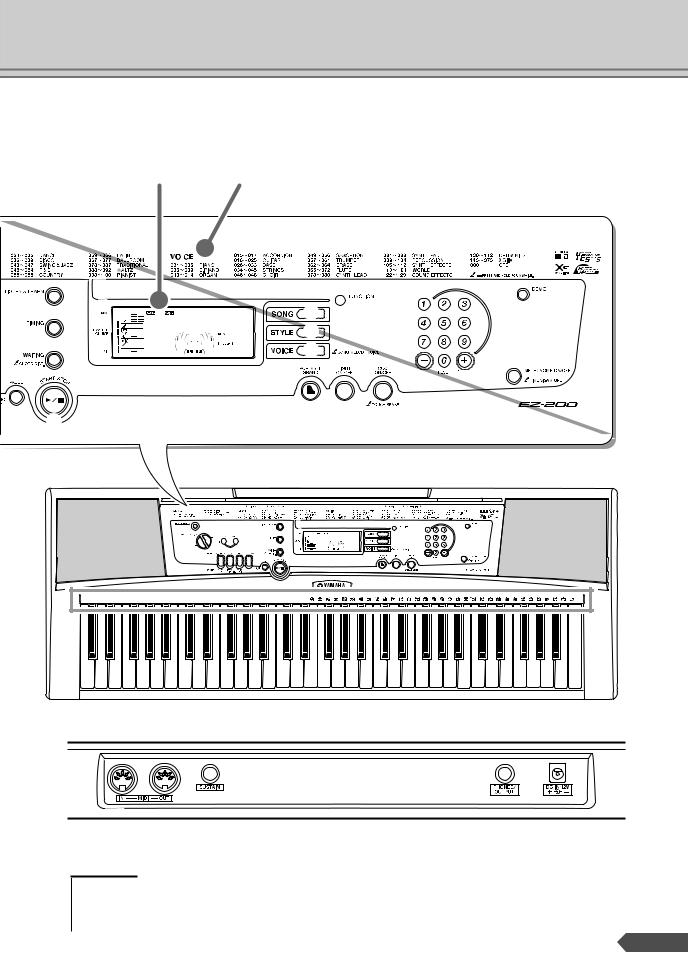
Panel Controls and Terminals
Display (page 28) |
Voice List (page 58) |
|
|
|
|
|
|
|
|
|
|
|
r |
|
|
u |
|
!2 |
|
|
|
|
|
||
|
|
001 |
GrandPno |
i |
|
|
|
t |
o |
|
!1 |
||
|
|
-03 |
|
|||
|
y |
|
|
!0 |
|
|
|
|
|
|
|
|
|
|
|
|
|
|
|
!3 |
!8 |
!9 |
|
|
@0 |
@1 |
@2 |
|
|
|
|
|
|


 001
001 GrandPno
GrandPno


 -03
-03
@3 





























■ Rear Panel
@4 |
@5 |
@6 |
@7 |
 CAUTION
CAUTION
•Playing while looking at the lights for a long period of time may cause eyestrain or stiffness in your neck and shoulders.
For your health and comfort, we recommend that you take a ten-minute break after every hour of playing.
EZ-200 Owner’s Manual |
11 |
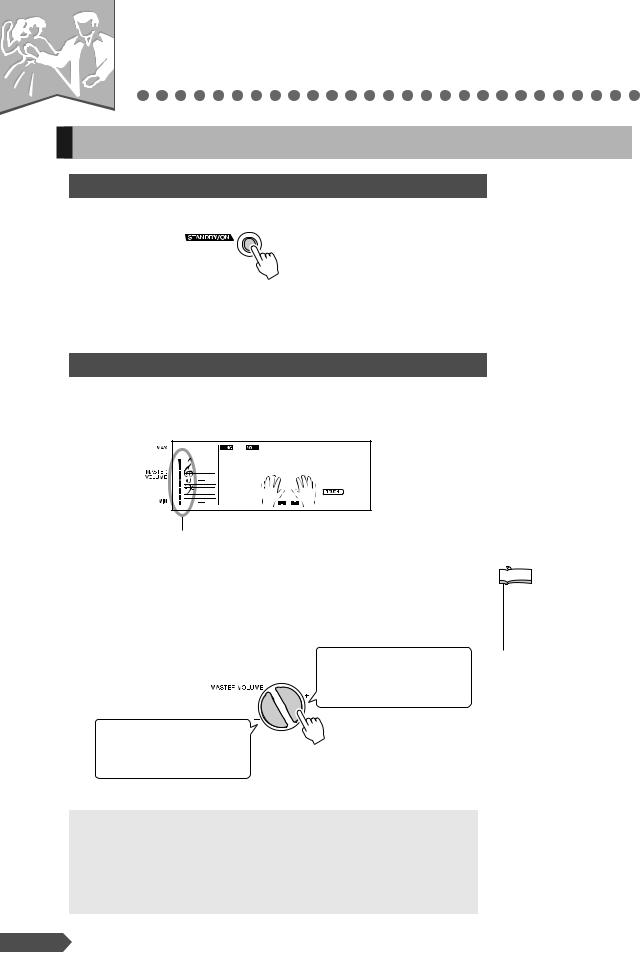
Step |
— Quick Guide — |
1 Playing the Songs |
|
Turn the power on and adjust the volume
Turning the power on
Press the [STANDBY/ON] switch to turn on the power.
Press the [STANDBY/ON] switch again to turn the power off.
Adjust the volume
When turning the power on, bars appear at the left side in the display to indicate the value of the master volume.


 001
001 GrandPno
GrandPno



 -03
-03
Displays the current volume.
When you first turn on the power, make sure to turn down the volume of the instrument by pressing the MASTER VOLUME [-] button several times. While playing the keyboard, adjust the volume level by using the MASTER VOLUME [+] and [-] buttons.
Press the [-] button to lower the volume. Pressing the [-] button twice decreases the bar indication in the display by one.
Press the [+] button to increase the volume. Pressing the [+] button twice increases the bar indication in the display by one.
If you are using the instrument in a quiet place and want a lower volume setting to start with, simultaneously hold down the MASTER VOLUME [-] button and turn on the power with the [STANDBY/ ON] switch. This automatically sets the value to 4 (indicated by two bars).
 NOTE
NOTE
•When the power is turned on, the initial value is automatically set to 12 (indicated by six bars in the display).
12 EZ-200 Owner’s Manual
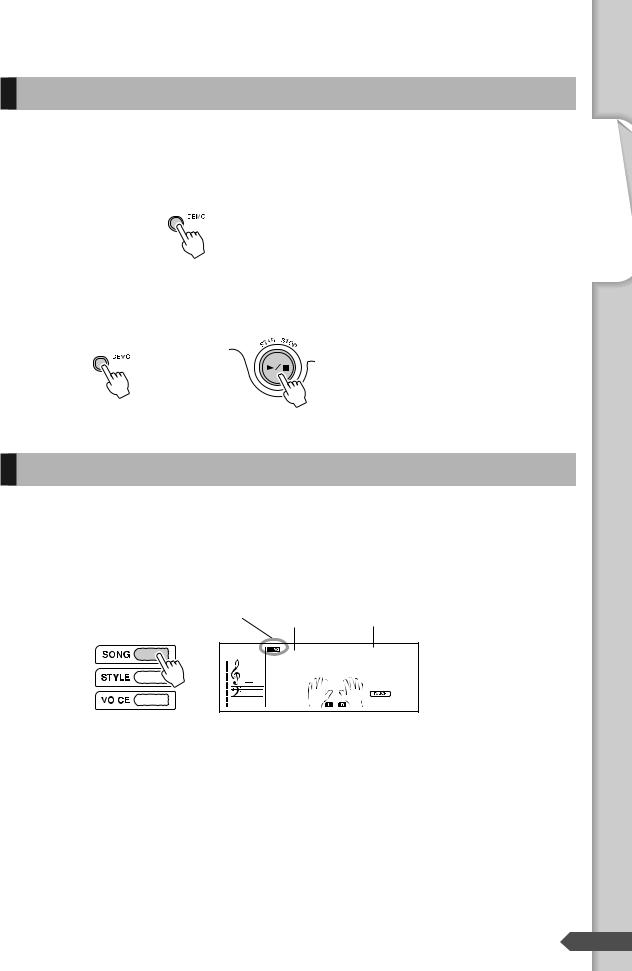
Listen to the Demo Songs
This instrument has 100 built-in Demo Songs.
To listen to the Songs, press the [DEMO] button.
The Songs play back in the Song number order.
Press the [DEMO] or [START/STOP] button again to stop the Song.
or
Selecting and listening to a specific Song
Select the desired song number and play it.
1 Press the [SONG] button.
The Song number and name are displayed.
Appears when the Song |
Song number |
Song name |
mode is active. |


 001 Bad Day
001 Bad Day



 -03
-03
Step 1 Playing the Songs Quick Guide
|
|
|
|
EZ-200 Owner’s Manual |
13 |
|
|
|
|
||
|
|
|
|

2
3
Select the desired Song by using the number buttons [0]–[9], [+], [-].
Refer to the Song List on page 15.
Press the [START/STOP] button.
The Song will begin playing.
You can stop playback at any time by pressing the [START/
STOP] button.
● Other Operations
[REW] button |
|
|
Fast-reverses through the Song if pressed during playback (no sound is |
||
|
heard during fast reverse). Decreases the measure number if pressed while |
|
|
playback is stopped. |
|
[FF] button............... |
Fast-forwards through the Song if pressed during playback. Increases the |
|
|
measure number if pressed while playback is stopped. |
|
[PAUSE] button ....... |
Temporarily stops playback. Press this button a second time to resume |
|
|
playback from the point at which it was stopped. |
|
14 EZ-200 Owner’s Manual

● Song List
No. |
Song Name |
|
No. |
Song Name |
|
Favorite |
|
035 |
Londonderry Air (Traditional) |
|
|
|
|
|
001 |
Bad Day (Daniel Powter) |
|
036 |
When Irish Eyes Are Smiling |
|
|
|
(E.R. Ball) |
|
002 |
Dancing Queen (Benny Andersson, |
|
|
|
|
|
|
||
Bjorn Ulvaeus, Sig Anderson) |
|
037 |
Muss I Denn (F. Silcher) |
|
|
|
|||
|
|
|
|
|
003 |
Daughters (John Mayer) |
|
038 |
America The Beautiful (S.A. Ward) |
|
|
|
|
|
004 |
Fallin’ (Alicia Keys) |
|
039 |
O Christmas Tree (Traditional) |
|
|
|
|
|
005 |
Hey Jude |
|
040 |
Jingle Bells (J.S. Pierpont) |
(John Lennon, Paul McCartney) |
|
|
|
|
|
|
041 |
Silent Night (F. Gruber) |
|
|
|
|
||
006 |
Linus And Lucy (Vince Guaraldi) |
|
|
|
|
042 |
Deck The Halls (Traditional) |
||
|
|
|
||
|
Since U Been Gone |
|
|
|
007 |
|
043 |
Amazing Grace (Traditional) |
|
(Martin Sandberg, Lukasz Gottwald) |
|
|||
|
|
|
|
Pianist |
008 |
You’re Beautiful (James Blunt, |
|
|
|
Sacha Skarbek, Amanda Ghost) |
|
044 |
Für Elise (L.v. Beethoven) |
|
|
|
|||
|
|
|
|
|
|
|
|
|
Etude op.10-3 “Chanson De L’adieu” |
009 |
Your Song |
|
045 |
|
(Elton John, Bernie Taupin) |
|
(F. Chopin) |
||
|
|
|
||
|
|
|
|
|
|
|
|
046 |
Turkish March (W.A. Mozart) |
010 |
Just The Way You Are (Billy Joel) |
|
||
|
|
|
|
|
|
|
|
|
Valse op.64-1 “Petit Chien” |
|
Standard |
|
047 |
|
011 |
Scarborough Fair (Traditional) |
|
|
(F. Chopin) |
|
|
|
||
|
048 |
Menuett/Beethoven |
||
|
|
|
||
012 |
Three Blind Mice (Traditional) |
|
||
|
(L.v. Beethoven) |
|||
|
|
|
|
|
013 |
O du lieber Augustin (Traditional) |
|
|
|
|
049 |
24 Preludes op.28-7 (F. Chopin) |
||
|
|
|
||
014 |
London Bridge (Traditional) |
|
|
|
|
050 |
Melodie (Album für die Jugend) |
||
|
|
|
||
015 |
Believe Me If All Those Endearing |
|
(R. Schumann) |
|
|
|
|||
Young Charms (Traditional) |
|
|
|
|
|
|
051 |
Fröhlicher Landmann (Album für die |
|
|
|
|
||
016 |
Ave Maria (F. Schubert) |
|
Jugend) (R. Schumann) |
|
|
|
|||
|
|
|
|
|
017 |
Grandfather’s Clock (H.C. Work) |
|
052 |
Träumerei (Kinderszenen) |
|
|
|
(R. Schumann) |
|
018 |
Twinkle Twinkle Little Star |
|
|
|
|
|
|
||
(Traditional) |
|
053 |
Thema (Impromptus D.935-3) |
|
|
|
|||
|
|
|
(F. Schubert) |
|
019 |
I’ve Been Working On The Railroad |
|
|
|
|
|
|
||
(Traditional) |
|
054 |
Invention Nr.1 (J. S. Bach) |
|
|
|
|||
|
|
|
|
|
020 |
Little Brown Jug (Traditional) |
|
055 |
Gavotte/J. S. Bach (J. S. Bach) |
|
|
|
|
|
021 |
When The Saints Go Marchin’ In |
|
056 |
Arietta/Grieg (E. Grieg) |
(Traditional) |
|
|
|
|
|
|
057 |
La Chevaleresque (J. F. Burgmüller) |
|
|
|
|
||
022 |
Aloha Oe (Q. Liliuokalani) |
|
|
|
|
058 |
Prelude (Wohltemperierte Klavier |
||
|
|
|
||
023 |
Home Sweet Home (H. Bishop) |
|
1-1) (J.S. Bach) |
|
|
|
|||
|
|
|
|
|
024 |
Loch Lomond (Traditional) |
|
059 |
Annie Laurie (Traditional) |
|
|
|
|
|
025 |
Bill Bailey (Won’t You Please Come |
|
060 |
Moments Musicaux op.94-3 |
Home) (H. Cannon) |
|
(F. Schubert) |
||
|
|
|
||
|
|
|
|
|
026 |
Down By The Riverside (Traditional) |
|
061 |
La Viollette (Streabbog) |
|
|
|
|
|
027 |
Aura Lee (G. Poulton) |
|
062 |
Menuett (L. Boccherini) |
|
|
|
|
|
028 |
Greensleeves (Traditional) |
|
063 |
The Entertainer (S. Joplin) |
|
|
|
|
|
029 |
My Bonnie (H.J Fulmer) |
|
|
Piano Ensemble |
030 |
Funiculi-Funicula (L. Denza) |
|
064 |
Nocturne op.9-2 (F. Chopin) |
|
|
|
|
|
031 |
Die Lorelei (F. Silcher) |
|
065 |
Ave Maria/J. S. Bach – Gounod |
|
|
|
(J. S. Bach / C. F. Gounod) |
|
032 |
Wenn ich ein Vöglein wär |
|
|
|
|
|
|
||
(Traditional) |
|
066 |
Piano Concerto No.21 2nd mov. |
|
|
|
|||
|
|
|
(W. A. Mozart) |
|
033 |
Turkey In The Straw (Traditional) |
|
|
|
|
|
|
||
|
|
|
|
Romanze (Serenade K.525) |
034 |
Old Folks At Home (S.C. Foster) |
|
067 |
|
|
(W. A. Mozart) |
|||
|
|
|
|
|
|
|
|
|
|
|
|
|
|
|
No. Song Name
068
Die Schlittenfahrt K.605-3
(W. A. Mozart)
069 Ave Verum Corpus (W. A. Mozart)
070
Piano Sonate op.27-2 “Mondschein”
(L.v. Beethoven)
071 Ode to Joy (L.v. Beethoven)
072 Canon (J. Pachelbel)
073 Air de Toreador “Carmen” (G. Bizet)
074 The SurpriseSymphony (F.J. Haydn)
075 Gavotte (F.J. Gossec)
076 Menuett (J.S. Bach)
077
String Quartet No.17 2nd mov. “Serenade” (F.J. Haydn)
078 Song Of The Pearl Fisher (G. Bizet)
079
Jesu, Joy Of Man’s Desiring
(J.S. Bach)
080
Der Vogelfänger bin ich ja (W. A. Mozart)
081 The Danube Waves (I. Ivanovici)
082
O Mio Babbino Caro (From “Gianni
Schicchi”) (G. Puccini)
083 Liebesträume Nr.3 (F. Liszt)
084 To A Wild Rose (E.A. MacDowell)
Classical
085
Waltz (The Sleeping Beauty)
(P. I. Tchaikovsky)
086 Air (Orchestral Suite) (J. S. Bach)
087 Siciliano/J. S. Bach (J. S. Bach)
088 Menuet (L’Arlésienne) (G. Bizet)
089
Largo (From the New World)
(A. Dvorák)ˇ
090 Pizzicato Polka (J. Strauss II)
091 Frühlingslied (F. Mendelssohn)
092
La Primavera (From Le Quattro
Stagioni) (A. Vivaldi)
093
Orphée Aux Enfers Ouverture
(J. Offenbach)
094
Danse Des Mirlitons From “The
Nutcracker” (P.I. Tchaikovsky)
095 Slavonic Dances No.10 (A. Dvorák)ˇ
096 Guillaume Tell (G. Rossini)
097 Méditation De Thais (J. Massenet)
098 Ungarische Tänze Nr.5 (J. Brahms)
099
Valse Des Fleurs (From “The
Nutcracker”) (P.I. Tchaikovsky)
100 Frühlingsstimmen (J. Strauss II)
• The Song 001–005, 007–009, 013, 014, 085–090 do not have a left part. Therefore, the lesson is applicable only for the right hand.
•Songs of he classic and/or traditional songs have been edited for length or for ease in learning, and may not be exactly the same as the original.
Step 1 Playing the Songs Quick Guide
EZ-200 Owner’s Manual |
15 |
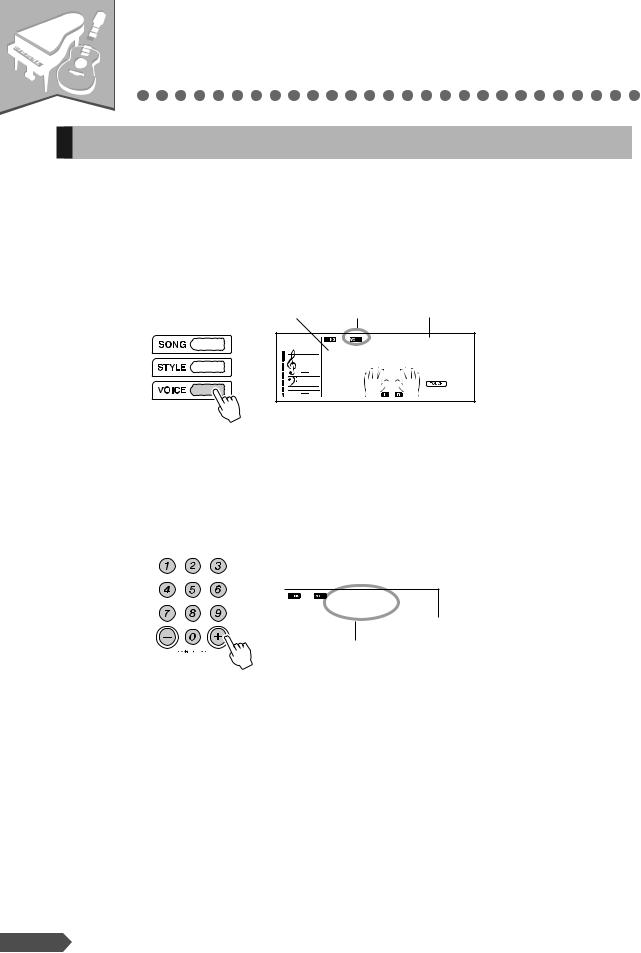
Step |
— Quick Guide — |
|
2 Changing the Voices
Changing the Voices
Try playing a variety of instrument Voices
In addition to the piano Voice, a wide variety of other instrument Voices can be selected and played, including guitar, trumpet and flute. The Voice selected here becomes the Main Voice.
1 Press the [VOICE] button.
The Voice number and name are displayed.
Appears when the |
|
Voice number Voice mode. |
Voice name |


 001
001 GrandPno
GrandPno



 -03
-03
2 Select a Voice.
Select the desired Voice by using the number buttons [0]–[9], [+], [-].
Refer to the Voice List on page 66.
 065
065 Flute
Flute
The Voice shown here becomes the Main
Voice for the instrument.
Selecting Voice number 000 (One Touch Setting) automatically calls the most suitable voice for the currently selected Style or Song. (Refer to page 38.)
16 EZ-200 Owner’s Manual

3 Play the keyboard.
Try selecting and playing different Voices.
Playing the Grand Piano Voice
When you simply want to play a piano Voice, all you have to do is press one convenient button.
Press the [PORTABLE GRAND] button.
The Voice “001 Grand Piano” will automatically be selected as the Main Voice.
Step 2 Changing the Voices Quick Guide
EZ-200 Owner’s Manual |
17 |

Drum kits
Drum kits are collections of drum and percussion instruments.
When drum kits (Voice numbers 130–142) are selected, you can play different percussion sounds directly from the keyboard.
1 Press the [VOICE] button.
2 Select the desired Drum kit.
Select one of the Voice numbers from 130–142 by using the number buttons [0]–[9], [+], [-].
Example: 130 Standard Kit
 130
130 Std.Kit1
Std.Kit1
|
|
|
|
|
Shot |
|
|
Closed Pedal |
|
Cymbal |
1 |
1 |
|
H Open |
|
|
|
|
|
|
Mute |
||
Tap |
Slap |
|
|
Rim |
|
Clap |
Open |
|
|
|
|
Short |
|
Mute |
|||||||||
|
|
|
|
|
|
|
|
|
|
||||||||||||||
|
|
|
|
|
|
Stick |
|
|
Cymbal |
|
L |
L |
L |
|
|
|
|
||||||
|
|
|
|
|
|
|
|
|
|
|
|
|
|
|
|
|
|
|
|
|
|||
Brush Brush |
|
CastanetSticks |
Open |
|
Side |
Hand |
Hi |
Hi |
Hi |
Crash |
Ride |
|
ambourine |
Conga |
TimbaleAgogo |
Maracas |
Guiro Claves |
Cuica |
Tri |
|
Shaker |
||
|
|
|
T |
CowbellVibraslap Bongo |
angle |
||||||||||||||||||
|
|
|
|
|
|
|
-Hat |
-Hat |
-Hat |
|
|
|
|
|
|
|
|
|
|
|
|
|
|
C3
Click |
H |
Swirl |
Swirl Roll |
H |
Soft |
Soft Hard |
Drum |
M |
Hard |
Tom |
L |
Tom |
H |
Tom |
Tom |
L |
Tom |
H |
|
Cymbal |
|
Cymbal |
2 |
|
2 |
H |
Mute |
|
L |
H |
|
H |
|
H |
|
L |
|
Block |
H |
|
L |
Open |
Open Bells Tree |
|||||||
|
|
H |
|
|
|
|
|
|
|
|
|
|
H |
|
|
|
|
Cabasa |
|
|
|
|
Block |
|
||||||||||||||||||||||||||
|
|
|
|
|
|
|
|
|
|
|
High |
Tom |
|
Cup |
CymbalCymbal |
|
|
|
|
|
|
|
|
WhistleWhistle |
|
Long |
|
|
|
|||||||||||||||||||||
|
|
|
Tap |
|
|
|
|
|
Snare |
|
|
|
|
|
Low |
|
|
|
|
|
|
|
|
|
|
|
Conga |
|
Agogo |
|
|
|
|
|
|
|
|
|
Bell |
|||||||||||
Seq Brush |
|
|
Snare |
|
|
Drum |
Drum Bass |
|
|
Floor Floor |
Mid Mid |
|
|
|
|
|
|
|
|
|
Bongo |
|
|
|
|
|
|
Guiro |
|
ood |
Cuica |
ngle |
Jingle |
|||||||||||||||||
|
|
|
|
Snare |
|
|
|
|
|
|
|
Cymbal |
|
|
|
|
|
Conga |
|
|
Timbale |
|
|
|
|
|
|
|
||||||||||||||||||||||
|
Brush |
|
Snare |
|
Bass |
|
|
|
|
|
|
|
|
|
|
Chinese |
|
Crash |
Ride |
|
|
|
|
|
|
|
|
|
Samba |
|
|
Wood |
W |
|
|
Tria |
|
|
||||||||||||
|
|
|
Bass |
|
|
|
|
|
|
|
|
|
|
|
|
|
|
|
|
|
|
|
|
|
|
|
|
|
|
|
|
|
|
|
|
|
|
|
|
|||||||||||
|
|
|
|
|
|
|
|
|
|
|
|
|
|
|
|
|
|
|
|
|
|
Ride |
Splash |
|
|
|
|
|
|
|
|
|
|
Samba |
|
|
|
|
|
|
|
|
|
|
|
|
||||
|
|
|
|
|
|
|
|
|
|
|
|
|
|
|
|
|
|
|
|
|
|
|
|
|
|
|
|
|
|
|
|
|
|
|
|
|
|
|
|
|
|
|
|
|
|
|
||||
* When Voice number 130 is selected, the icons printed above the keyboard indicates the instruments assigned to each key.
18 EZ-200 Owner’s Manual
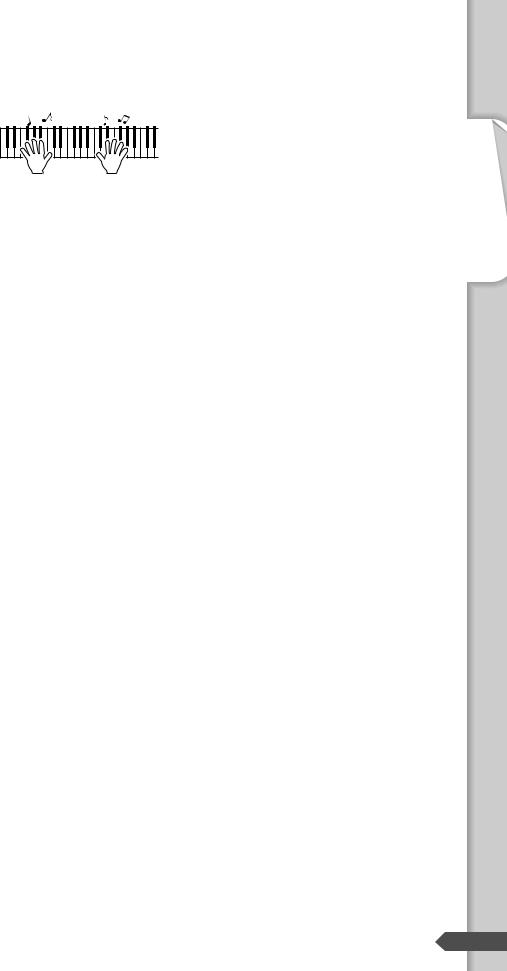
3 Try out each key.
You’ll hear bongo drums, congas, maracas, and more—a comprehensive variety of drum and percussion sounds.
Details on the instruments and key assignments of each drum kit can be found in the Drum Kit List on page 63.
● Drum Kit List
130 |
Standard Kit 1 |
|
|
131 |
Standard Kit 2 |
|
|
132 |
Room Kit |
|
|
133 |
Rock Kit |
|
|
134 |
Electronic Kit |
|
|
135 |
Analog Kit |
|
|
136 |
Dance Kit |
|
|
137 |
Jazz Kit |
|
|
138 |
Brush Kit |
|
|
139 |
Symphony Kit |
|
|
140 |
SFX Kit 1 |
|
|
141 |
SFX Kit 2 |
|
|
142 |
Sound Effect Kit |
|
|
Step 2 Changing the Voices Quick Guide
EZ-200 Owner’s Manual |
19 |
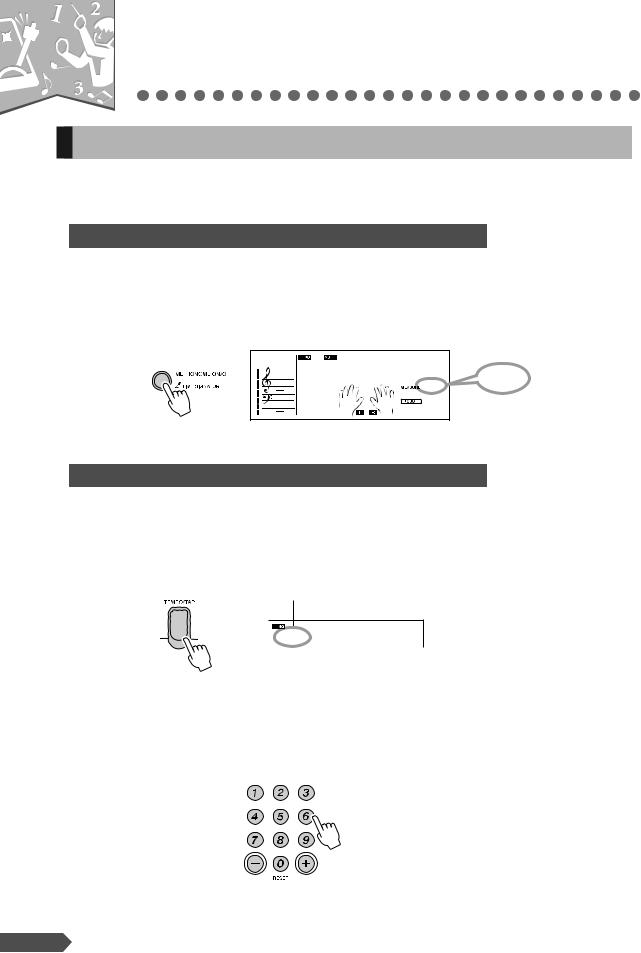
Step |
— Quick Guide — |
|
3 Play with the metronome
Start the metronome
The instrument includes a metronome with adjustable tempo and time signature. Play and set the tempo that is most comfortable for you.
Starting the metronome
Turn the metronome on and start it by pressing the [METRONOME ON/ OFF] button.
To stop the metronome, press the [METRONOME ON/OFF] button again.


 001
001 GrandPno
GrandPno
1 1
Displays the current beat.
Setting the metronome tempo
Adjust the metronome tempo
1 Press the [TEMPO/TAP] button to display the tempo.
Current Tempo value
 070 Tempo
070 Tempo
2 |
Set the metronome tempo by using the number buttons [0]–[9], [+], |
|
[-]. |
The tempo can be adjusted between 11–280.
20 EZ-200 Owner’s Manual
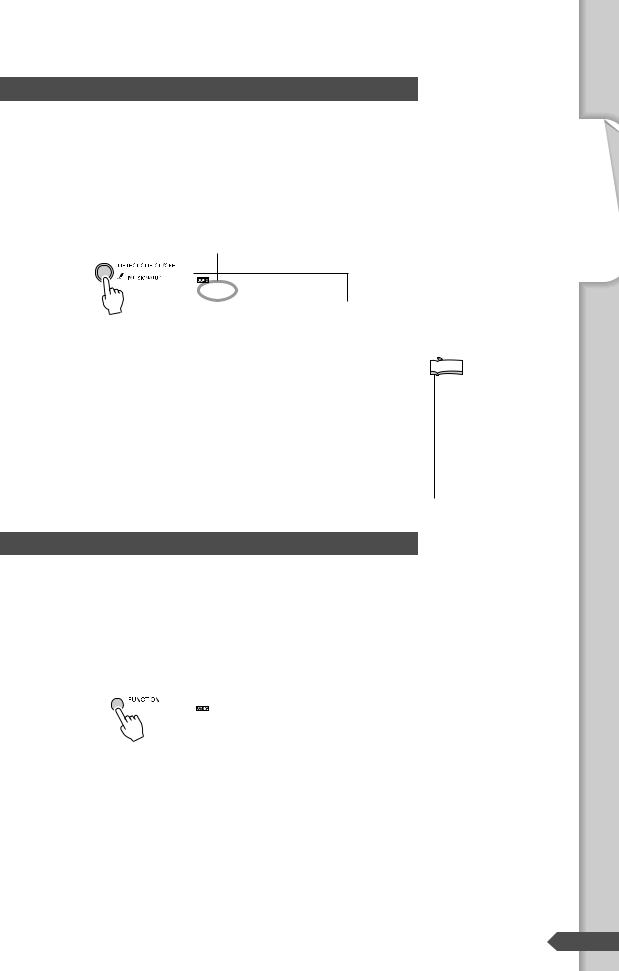
Setting the numerator of the metronome time signature
Set the number of beats per measure.
1 Press and hold the [METRONOME ON/OFF] button for longer than a second.
Current numerator appears.
Time signature numerator
|
04 TimeSigN |
|
Hold longer than |
|
a second |
2 |
Set the time signature numerator (0–60) by using |
|
the number buttons [0]–[9], [+], [-]. |
The first beat is accented with a bell sound and the rest with clicks. When set to 00, the metronome sounds all beats with a click sound (no accent).
 NOTE
NOTE
•The time signature numerator cannot be changed when a Style or Song is playing since it is automatically preset for the most suitable time signature of the current Style or Song. Make sure to stop the Style or Song before setting the numerator.
Setting the denominator of the metronome time signature
Sets the basic note value for each measure.
1 |
Press the [FUNCTION] button a number of times until “TimeSigD” |
||||
|
appears. |
||||
|
|
|
|
|
|
|
|
|
|
04 TimeSigD |
|
2 |
Set the time signature denominator by using the number buttons [+], |
||||
|
[-]. |
|
|
|
|
The available denominators are 02 (1/2 note;  ), 04 (1/4 note;
), 04 (1/4 note;  ), 08 (1/8 note;
), 08 (1/8 note;  ) and 16 (1/16 note;
) and 16 (1/16 note;  ).
).
Step 3 Play with the metronome Quick Guide
EZ-200 Owner’s Manual |
21 |

Setting the metronome volume
1 |
Press the [FUNCTION] button a number of times until “MetroVol” |
|||||
|
appears. |
|||||
|
|
|
|
Metronome volume |
||
|
|
|
|
|
|
|
|
|
|
|
|
|
|
|
|
|
|
|
|
|
|
|
|
|
100 MetroVol |
|
|
2 |
Set the metronome volume (000–127) by using the number buttons |
|||||
|
[0]–[9], [+], [-]. |
|||||
22 EZ-200 Owner’s Manual

Step |
— Quick Guide — |
4 |
Play with a Style |
Selecting a rhythm of a Style
The Style feature provides backing and rhythm parts in a wide variety of musical categories, including rock, blues, disco and much more. Here’s how to play a rhythm of a Style. The rhythm sound consists of percussion instruments.
1 Press the [STYLE] button.
The Style number and name are displayed.
Appears when Style |
|
Style number mode is active. |
Style name |

 001 8BtModrn
001 8BtModrn



 001
001
2 Select a Style.
Select the desired Style by using the number buttons [0]–[9], [+], [-].
Refer to the Style List on page 66.
016 HH Light
3 Press the [START/STOP] button.
The Style will begin playing.
You can stop the style at any time by pressing the [START/STOP] button.
 NOTE
NOTE
•Since the Pianist category Styles (093–100) have no rhythm parts, no sound will be produced if you start rhythm-only playback. To use these Styles, turn on the auto accompaniment and play the keyboard as described on pages 24–25. (The bass and chord accompaniment parts will sound.)
Step 4 Play with a Style Quick Guide
EZ-200 Owner’s Manual |
23 |
